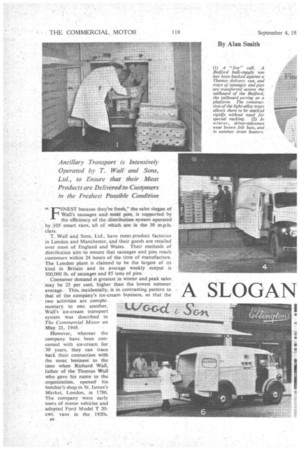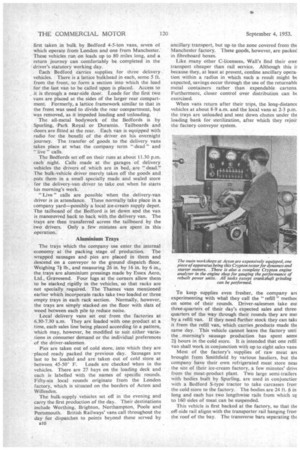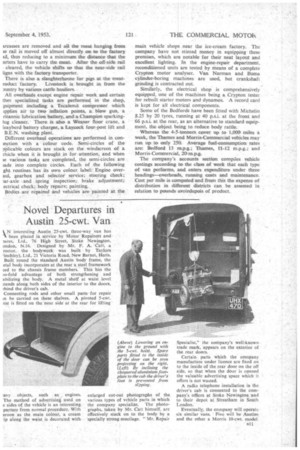A SLOGAN LIVES ON TRANSPORT
Page 42

Page 43

Page 44

Page 45

If you've noticed an error in this article please click here to report it so we can fix it.
"' INEST because they're fresh," the sales slogan of Wall's sausages and meat pies, is supported by the efficiency of the distribution system. operated by 103 smart vans, WI of which are in the 30 m.p.h., class.
T. Wall and Sons, Ltd., have meat-product factories in London and Manchester, and their goods are retailed over most of England and Wales. Their methods of distribution aim to ensure that sausages and pies reach customers within 24 hours of the time of manufacture. The London plant is claimed to be the largest of its kind in Britain and its average weekly Output is 500,000 lb. of sausages and 85 tons of pies.
Consumer demand is greatest in winter and peak sales may be 25 per cent, higher than the. lowest summer average. This, incidentally, is in contrasting pattern to that of the company's ice-cream business, so that the two activities are complementary to one another. Wall's ice-cream transport system was described in The Commercial Motor on May 21, 1948.
However, whereas the company have been concerned with ice-cream for, .30 years, they can trace back their connection, with the meat business to the time when Richard Wall, father of the Thomas Wall who gave his name to the organization, opened his butcher's shopin St. James's Market, London, in 1786. The company were early users of motor vehicles and adopted Ford Model T 20cwt. vans in the 1920s.
Many driver-salesmen still with Wall's recall using these vehicles.
Today, most of the delivery vans are 2-tonners of Ford manufacture. They are standard Thames-Garner boxvans with accommodation in the cab for the driverSalesman and his young assistant. There is no bulkhead bchind the cab. Roller shutters are fitted at the rear. Some of the vans have racks for trays, but Wall's methods of loading do not make racking imperative. There are 80 vehicles of this type and they are supplemented by 15 Morris-Commercial 1-type 10-cwt. vans which work shorter rounds than the 2-tormers.
Two of the latest deliveries to the fleet are Thames vans with four-cylindered engines and registration numbers in the new style. The electrical circuits have been changed from 6 volts to 12 volts. The manufacturers are checking these vehicles in their early stages of use.
• Deliveries direct from the factories can most conveniently be made up to a radius of approximately 35 miles. Consignments to more distant customers are first taken in bulk by Bedford 4-5-ton vans, seven of which operate from London and one from Manchester. These vehicles run on leads up to 80 miles long, and a return journey can comfortably be completed in the driver's statutory working day.
Each Bedford carries supplies for three delivery vehicles. There is a lattice bulkhead in each, some 5 ft. from the front, to form a section into which the load for the last van to be called upon is placed. Access to it is through a near-side door. Loads for the first two vans are placed at the sides of the larger rear compartment. Formerly, a lattice framework similar to that in the front was used to divide the rear compartment, but was removed, as it impeded loading and unloading.
The all-metal bodywork of the Bedfords is by Spurting, ,Park Royal or Duramin. Tailboards and doors are fitted at the rear. Each van is equipped with radio for the benefit of the driver on his overnight journey. The transfer of goods to the delivery vans takes place at what the company term " dead " and "live" calls.
The Bedfords set oil on their runs at about 11.30 p.m. each night. Calls made at the garages of delivery vehicles the drivers of which are in bed, are "dead." The bulk,vehicle driver merely takes off the goods and puts them in a small specially made and sealed store for the delivery-van driver to take out when he starts his morning's work.
" Live " calls are possible when the delivery-van driver is in attendance. These normally take place in a company yard—possibly a local ice-cream supply depot. The tailboard of the Bedford is let down and the van is manoeuvred back to back with the delivery van. The trays are then transferred across the tailboard by the two drivers. Only a few minutes are spent in this operation.
Aluminium Trays The trays which the company use enter the internal economy at the packing stage of production. The wrapped sausages and pies are placed in them and descend on a conveyor to the ground dispatch floor. Weighing 7i lb., and measuring 26 in. by 16 in. by 6 in., the, trays are aluminium pressings made by Essex Aero, Ltd., Gravesend. Four lugs at the corners allow them to be stacked rigidly in the vehicles, so that racks are not specially required. The Thames vans mentioned earlier which incorporate racks take two loaded or three empty trays in each rack section. Normally, however, the trays are simply stacked on the floor with slats of wood between each pile to reduce noise.
Local delivery vans set out from the factories at 6.30-7.30 a.m. They are loaded with one product at a time, each sales line being placed according to a pattern, which may, however, be modified to suit either variations in consumer demand or the individual preferences of the driver-salesmen.
• Pies are taken out of cold store, into which they are placed ready packed the previous day. Sausages are last to be loaded and are taken out of cold store at between 45-50° F. Loads are checked when in the vehicles. There are 27 bays on the loading deck and each is labelled with the names of specific rounds. Fifty-six local rounds originate from the London factory, which is situated on the borders of Acton and Willesden.
The bulk-supply vehicles set off in the evening and carry the first production of the day. Their destinations include Worthing, Brighton, Northampton, Poole and Portsmouth. British Railways' vans call throughout the day for dispatches to points beyond those served by ancillary transport, but up to the zone covered from tht Manchester factory. These goods, however, are packed in fibreboard boxes.
Like many other C-licensees, Wall's find their own transport cheaper than rail service. Although this i.! because they, at least at present, confine ancillary operation within a radius in which such a. result might bt expected, savings occur through the use of the returnable metal containers rather than expendable cartons. Furthermore, Closer control over distribution can be exercised.
When vans return after their trips, the long-distance vehicles at about 8-9 a.m. and the local vans at 2-3 p.m. the trays are unloaded and sent down chutes under the loading bank for sterilization, after which they rejoir the factory conveyor system.
To keep supplies even fresher, the company art experimenting with what they call the "refill " methoc on some of their rounds. Driver-salesmen take oui three-quarters of their day's expected sales and three. quarters of the way through their rounds they are mei by a refill van. If they need further stock they can takt it from the refill van, which carries ,products made tht same day. This vehicle cannot leave the factory until the morning's sausage production has spent some 24 hours in the cold store. It is intended that one refit Van shall work in conjunction with up to eight sales vans Most of the factory's supplies of raw meat art brought from Smithfield by various hauliers, but tht company have their own refrigerated meat store nem the site of their ice-cream factory, a few minutes' drive from the meat-product plant. Two large semi-trailers with bodies built by Spurting, are used in conjunctior with a Bedford S-type tractor to take carcasses frorr the cold store to the factory. The bodies are 24 ft. 6 in long and each has two lengthwise rails from which ur to 160 sides of meat can be suspended.
This vehicle is first backed at the factory, so that tht off-side rail aligns with the transporter rail hanging fronthe roof of the bay. The transverse bars separating the trcasses are removed and all they meat hanging. from le rail is moved off almost directly on to the factory til, thus reducing to a minimum. the distance that the otters have to carry the meat. After the off-side rail cleared, the vehicle shifts so that the near-side rail ligns with the factory. transporter.
There is also, a slaughterhouse for pigs at the mea roduct factory. Livestock is brought in. from the Yuritry by various cattle hauliers..
All overhauls except engine repair work and certain ther specialized tasks. are performed in the shop, luipment including. a Tecalemit compressor which applies air to two inflation perints, a blow gun, a ritannic lubrication battery,. and &Champion sparkinglug cleaner. There is, also a Weaver floor crane, a leayberd battery charger; a Laycock fourpost lift and B.E.N. washing plant.
Different overhaul operations are performed in coninction with a colour code: Semi-circles of the p'plicable colours are stuck on the windscreen of a :hicle when it is brought in for 'attention, and when le various tasks are completed, the semi-circles are Lade into complete circles. Each of the following ght. routines, has its own colour. label: Engine overaul„ gearbox and selector service; steering check; :ar-axle and spring inspection; brake adjustment; ectrical check; .body repairs; painting.
Bodies are repaired and vehicles are painted at the main vehicle shops near the ice-cream factory. The company have not stinted money in equipping these premises, which are notable for their neat layout and excellent lighting. In the engine-repair department. reconditioned units are tested by means of a complete Crypton motor analyser. Van Norman and Marna cylinder-boring machines are used, but crankshaft grinding, is contracted out.
Similarly, the electrical shop is comprehensively equipped, one of the machines being a Crypton tester for rebuilt starter motors and dynamos. A record card is kept for all electrical components.
Some of the Bedfords have been fitted with Michelin 8.25 by 20 tyres, running at40 p.s.i, at the front and 66 p.s.i. at the rear, as an alternative to standard equipment, the object being to reduce body rattle.
Whereas the 4-5-tormers cover up to 1,000. miles a week, the Thames and Morris-Commercial vehicles may run up. to only 25t1 Average fuel-consumption rates are Bedford 13 m.p.g.; Thames, LI-12 m.p.g.; and Morris-Commercial, 20' m.p.g.
The company's accounts section compiles vehicle costings according to. the class of work that each type of van performs, and, enters expenditure under three headings—overheads,, running costs and maintenance. Cost per mile is computed and from this the expense of distribution in different districts can be assessed in relation to pounds avoirdupois of product.




















































































